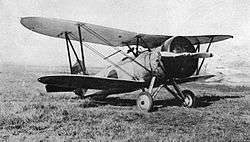Nakajima A2N
| A2N | |
|---|---|
 | |
| A2N1 | |
| Role | Carrier-borne fighter |
| Manufacturer | Nakajima Aircraft Company |
| Designer | Takao Yoshida |
| First flight | 1929 |
| Introduction | 1932 |
| Primary user | Imperial Japanese Navy |
| Produced | 1932-1936 (A2N) |
| Number built | approx 100 (A2N) + 66 (A3N) |
|
| |
The Nakajima A2N or Navy Type 90 Carrier-based fighter was a Japanese carrier-borne fighter of the 1930s. It was single-engine, biplane of mixed construction, with a fixed, tailwheel undercarriage.
Design and development
The A2N was originally developed as a private venture by Nakajima for the Imperial Japanese Navy. It was based loosely on the Boeing Model 69 and Boeing Model 100, examples of both having been imported in 1928 and 1929 respectively. Takao Yoshida led the design team. Two prototypes, designated 'Navy Type 90 Carrier-based fighter' in anticipation of Navy acceptance were ready by December 1929.[1] Powered by Bristol Jupiter VI engines, these were rejected, not being regarded as offering a significant improvement over the Nakajima A1N.[2]
Jingo Kurihara carried out a partial redesign and another prototype, the A2N1, powered by a 432 kW (580 hp) Nakajima Kotobuki 2, was completed in May 1931. The type was adopted by the Navy in April 1932.[2] In 1932, Minoru Genda formed a flight demonstration team known as "Genda's Flying Circus" to promote naval aviation and flew this type.
A two-seat trainer was later developed from the Navy Type 90 Carrier-based fighter as the A3N1 and 66 of these were built between 1936 and 1939.[2]
Operational history
The Navy Type 90 Carrier-based fighter flew from the Hōshō, Kaga and Ryūjō.
Variants

- A2N1
- (Navy Type 90-I Carrier-based fighter) - Guns located in both sides of the nose, but few produced.
- A2N2
- (Navy Type 90-II Carrier-based fighter) - Guns transferred to the upper surface of the nose, the fuel tanks mounted on the fuselage sides.
- A2N3
- (Navy Type 90-III Carrier-based fighter) - principal production variant. 5° of dihedral on upper mainplane.
- A3N3-1
- two-seat trainer
Specifications (A2N1)
Data from Japanese Aircraft, 1910-1941;[2] The Complete Book of Fighters[3]
General characteristics
- Crew: 1
- Length: 6.18 m (20 ft 3⅜ in)
- Wingspan: 9.37 m (30 ft 9 in)
- Height: 3.20 m (9 ft 11 in)
- Wing area: 19.74 m² (212.5 ft²)
- Empty weight: 1,045 kg (2,304 lb)
- Loaded weight: 1,550 kg (3,417 lb)
- Powerplant: 1 × Nakajima Kotobuki 2 nine cylinder air-cooled radial engine, 433 kW (580 hp)
Performance
- Maximum speed: 293 km/h (158 knots, 182 mph) at 3,000 m (9,845 ft)
- Cruise speed: 166 km/h (90 knots, 103.6 mph)
- Range: 501 km (270 nmi, 311 mi)
- Service ceiling: 9,000 m (29,500 ft)
- Wing loading: 78.5 kg/m² (16.1 lb/ft²)
- Endurance: 3 hours
- Climb to 3,000 m (9,845 ft): 5.75 min
Armament
- Guns: 2× 7.7 mm (0.303 in) Type 97 machine guns
See also
- Related development
- Aircraft of comparable role, configuration and era
- Related lists
References
| Wikimedia Commons has media related to Nakajima A2N. |
- Notes
- ↑ Mikesh and Abe 1990, p. 225.
- 1 2 3 4 Mikesh and Abe 1990, p. 226.
- ↑ Green and Swanborough 1994, p. 423.
- Bibliography